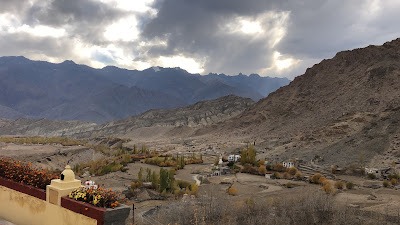
Image Source: Salil Baliyan
About Sham Valley Circuit
Sham Valley Circuit, often referred to as the “Baby Trek” of Ladakh, is nestled in the lower altitudes of Ladakh. The title “Baby” presents you with a different picture, but don’t let the title fool you; this circuit offers a rare blend of ancient monasteries, charming villages, dramatic landscapes and cultural immersion. The trek is ideal, especially for those seeking authenticity with a touch of comfort.
Geography
Sham Valley lies west of Leh , in the tehsils of Likir and Tingmosgang, along the route to Kargil. Unlike the higher-altitude regions of Ladakh, Sham Valley’s terrain is gentler, with elevations ranging between 3,000 and 3,800 metres. The region is dotted with barley fields, poplar-lined roads, and flowing tributaries of the Indus River. With Ladakh’s characteristic stark mountains in the backdrop, Sham Valley provides a scenic contrast of green fields and golden monasteries.
Why Travellers Love Sham Valley
* Cultural richness: Villages like Likir, Alchi, Basgo, Temisgam, Yangthang, and Hemis Shukpachan offer a sneak peek into traditional Ladakhi lifestyles.
* Less crowded: Compared to popular spots like Pangong or Nubra, Sham Valley is quieter, making it a paradise for solitude-seeking travelers.
* Monastic trail: The circuit is home to some of Ladakh’s oldest monasteries, such as Alchi Gompa (11th century) and Likir Monastery.
* Day hikes or overnight stays: Travellers can choose between homestays in villages or day trips from Leh, depending on time and comfort.
Main Highlights on the Sham Valley Circuit
# 1. Likir Monastery
Located about 52 km from Leh, this monastery belongs to the Gelugpa sect and houses a 75-foot-tall gilded Maitreya Buddha. The monastery is set on a hilltop, offering spectacular views of the valley.
# 2. Alchi Monastery
Unlike most Ladakhi monasteries perched on hills, Alchi is located on flat ground near the Indus. It’s famous for its Indo-Himalayan artwork and ancient wall paintings—a treasure for art lovers and historians.
# 3. Basgo Fort and Monastery
A historical gem, Basgo is known for its mud-brick fortress and three temples. Though partially in ruins, its setting against copper-colored cliffs makes it photogenic and mystical.
# 4. Hemis Shukpachan
The heart of the Sham Valley trek, this village is surrounded by pine trees (shukpa), rare in Ladakh. With traditional homes, terraced farms, and sacred sites, it offers a slow and soulful experience. Local homestays add to its appeal.
# 5. Temisgam
Once the capital of western Ladakh, Temisgam has palace ruins and a monastery with stunning views. It’s perfect for travelers interested in archaeology and quiet village walks.
Trekking or Driving the Circuit
Travellers can approach Sham Valley in two ways:
* By Road Trip: Rent a vehicle from Leh and do the circuit in 2–3 days, staying overnight in homestays.
* By Trekking: The Sham Valley Trek (Yangthang to Temisgam or vice versa) takes 3–4 days, suitable even for beginners. The trails are well-marked, and elevation gain is minimal.
Homestays & Cultural Exchange
What truly sets the Sham Valley apart is its network of homestays, supported by local communities. Staying in these homes, enjoy authentic Ladakhi meals, learn about farming traditions, and participate in daily life—an unmatched cultural exchange.
Best Time to Visit
May to September is ideal, with moderate weather and open roads. Spring brings blooming apricot trees, while summer ensures clear skies and accessible passes.
